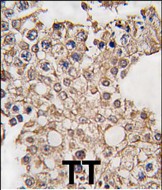GRK4 Antibody (C-term)
Purified Rabbit Polyclonal Antibody (Pab)
- SPECIFICATION
- CITATIONS: 1
- PROTOCOLS
- BACKGROUND

Application
| IHC-P, WB, E |
|---|---|
| Primary Accession | P32298 |
| Reactivity | Human |
| Host | Rabbit |
| Clonality | Polyclonal |
| Isotype | Rabbit IgG |
| Calculated MW | 66583 Da |
| Antigen Region | 549-577 aa |
| Gene ID | 2868 |
|---|---|
| Other Names | G protein-coupled receptor kinase 4, G protein-coupled receptor kinase GRK4, ITI1, GRK4, GPRK2L, GPRK4 |
| Target/Specificity | This GRK4 antibody is generated from rabbits immunized with a KLH conjugated synthetic peptide between 549-577 amino acids from the C-terminal region of human GRK4. |
| Dilution | IHC-P~~1:10~50 WB~~1:1000 E~~Use at an assay dependent concentration. |
| Format | Purified polyclonal antibody supplied in PBS with 0.09% (W/V) sodium azide. This antibody is prepared by Saturated Ammonium Sulfate (SAS) precipitation followed by dialysis against PBS. |
| Storage | Maintain refrigerated at 2-8°C for up to 2 weeks. For long term storage store at -20°C in small aliquots to prevent freeze-thaw cycles. |
| Precautions | GRK4 Antibody (C-term) is for research use only and not for use in diagnostic or therapeutic procedures. |
| Name | GRK4 |
|---|---|
| Synonyms | GPRK2L, GPRK4 |
| Function | Specifically phosphorylates the activated forms of G protein- coupled receptors. GRK4-alpha can phosphorylate rhodopsin and its activity is inhibited by calmodulin; the other three isoforms do not phosphorylate rhodopsin and do not interact with calmodulin. GRK4-alpha and GRK4-gamma phosphorylate DRD3. Phosphorylates ADRB2. |
| Cellular Location | Cytoplasm. Cytoplasm, cell cortex. Note=Both at the cell surface and dispersed in the cytoplasm under basal conditions Receptor stimulation results in the internalization of GRK4 to the perinuclear area, where colocalization with DRD3 is observed strongly at 5 and 15 minutes. DRD3 and GRK4 colocalize in lipid rafts of renal proximal tubule cells |
| Tissue Location | Isoform 1, isoform 2, isoform 3, and isoform 4 are expressed in testis. Isoform 4 is expressed in myometrium |

Provided below are standard protocols that you may find useful for product applications.
Background
Protein kinases are enzymes that transfer a phosphate group from a phosphate donor, generally the g phosphate of ATP, onto an acceptor amino acid in a substrate protein. By this basic mechanism, protein kinases mediate most of the signal transduction in eukaryotic cells, regulating cellular metabolism, transcription, cell cycle progression, cytoskeletal rearrangement and cell movement, apoptosis, and differentiation. With more than 500 gene products, the protein kinase family is one of the largest families of proteins in eukaryotes. The family has been classified in 8 major groups based on sequence comparison of their tyrosine (PTK) or serine/threonine (STK) kinase catalytic domains. The AGC kinase group consists of 63 kinases including the cyclic nucleotide-regulated protein kinase (PKA & PKG) family, the diacylglycerol-activated/phospholipid-dependent protein kinase C (PKC) family, the related to PKA and PKC (RAC/Akt) protein kinase family, the kinases that phosphorylate G protein-coupled receptors family (ARK), and the kinases that phosphorylate ribosomal protein S6 family (RSK).
References
Perroy, J., et al., EMBO J. 22(15):3816-3824 (2003).
Watanabe, H., et al., Kidney Int. 62(3):790-798 (2002).
Sallese, M., et al., J. Biol. Chem. 272(15):10188-10195 (1997).
Premont, R.T., et al., J. Biol. Chem. 271(11):6403-6410 (1996).
Sallese, M., et al., Biochem. Biophys. Res. Commun. 199(2):848-854 (1994).
If you have used an Abcepta product and would like to share how it has performed, please click on the "Submit Review" button and provide the requested information. Our staff will examine and post your review and contact you if needed.
If you have any additional inquiries please email technical services at tech@abcepta.com.














 Foundational characteristics of cancer include proliferation, angiogenesis, migration, evasion of apoptosis, and cellular immortality. Find key markers for these cellular processes and antibodies to detect them.
Foundational characteristics of cancer include proliferation, angiogenesis, migration, evasion of apoptosis, and cellular immortality. Find key markers for these cellular processes and antibodies to detect them. The SUMOplot™ Analysis Program predicts and scores sumoylation sites in your protein. SUMOylation is a post-translational modification involved in various cellular processes, such as nuclear-cytosolic transport, transcriptional regulation, apoptosis, protein stability, response to stress, and progression through the cell cycle.
The SUMOplot™ Analysis Program predicts and scores sumoylation sites in your protein. SUMOylation is a post-translational modification involved in various cellular processes, such as nuclear-cytosolic transport, transcriptional regulation, apoptosis, protein stability, response to stress, and progression through the cell cycle. The Autophagy Receptor Motif Plotter predicts and scores autophagy receptor binding sites in your protein. Identifying proteins connected to this pathway is critical to understanding the role of autophagy in physiological as well as pathological processes such as development, differentiation, neurodegenerative diseases, stress, infection, and cancer.
The Autophagy Receptor Motif Plotter predicts and scores autophagy receptor binding sites in your protein. Identifying proteins connected to this pathway is critical to understanding the role of autophagy in physiological as well as pathological processes such as development, differentiation, neurodegenerative diseases, stress, infection, and cancer.


